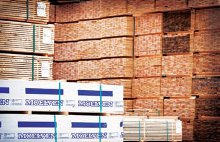Scouting for opportunity
16 June 2014Camilla Hair of Snows Timber looks back at a decade of changing emphasis in compliance and at what the future holds.
With the World Cup upon us, talent scouts for Britain's business-oriented premier football clubs will be among those watching. Similarly influenced by global resource availability, timber importers are constantly scouting for likely rule-book changes on the compliance playing field. Approaching a decade since it first gained dual FSC/PEFC certification, Snows Timber remains alert to the business opportunities being flagged up by developments in compliance.
"Looking constantly ahead we estimate how certain trends could affect our commercial development," said Snows Timber procurement director John Lloyd. "Will certain societal values or assessment methods enable us to develop a wider portfolio of customers or gain greater business? It's a different way of approaching certification and compliance, but it's enabled us to achieve our business goals over the past 10 years.
"As it was initially with certification, issues like waste reduction, invisible a decade ago, now influence daily commercial practice," he continued. "Today we buy more packaged to length and length-specific material than any other type, to minimise waste through to the end user. Sustainability issues now play a far greater part in business, encouraging efficiency gains. Yet reputational capital has mainly accrued from the work we started many years ago with chain of custody certification."
Perspective on certification systems depends where in the supply chain - and where in the world - a business operates. In Britain, public sector timber procurement policy is key, said Snows managing director Jim Peryer.
"Certification isn't a tick-box exercise; it's essential to doing business," he said. "The UK government's emphasis on legal and sustainable timber is clearly having an effect on the supply chain, though it's taken a while for the message to filter through to daily procurement practices."
In Germany, Carsten Kullik, CEO of Kullik & Rullman AG, sees certification from a different perspective. "The most market pressure for certified timber still comes from the UK, with Germany and France following behind. Italy has lower demand, and the Middle East and Japan even less than that," he said. "We undertook PEFC chain of custody 10 years ago but added FSC more recently when customers requested it, even though 100% of the wood grown in Germany is PEFC."
Offering a choice of certification has become almost the norm over the past decade. Moelven recognised the business potential of dual certification with supply chain partners like Snows Timber, as its UK joinery sales manager Russ Fletcher explained. "We originally had PEFC certification and have added FSC in the last few years. It's definitely helped to increase volumes to UK customers such as Snows.
"Obtaining sufficient FSC certified logs initially was a problem but Moelven has helped small forest owners to take up FSC certification and availability has definitely increased as a result."
Robert Svensson, managing director at QP Timber, agents for several Swedish sawmills, also recognises the business benefits of dual certification. "The UK market is still very much focused on chain of custody as a marketing tool," he said.
"Adding different certifications to a Swedish sawmill's portfolio can improve its prospects. Bergs sawmill added FSC to its original PEFC some years ago and has maintained its business levels with customers, like Snows. Today, being adaptable on certification is fundamental to doing business with Britain.
"As the EUTR has not long been with us, we've no idea where the future balance will lie between this and certification," he added. Could the EUTR affect the demand for certification? The question is certainly being asked.
Patrick Towner, UK sales manager at UPM's Timber Division, believes there's a need for both. "The EUTR has added another layer of compliance to everyone's systems, but forest management and chain of custody certification are still needed," he said.
"People who own forests or procure from them still have to demonstrate that they are managing those resources sustainably. The EUTR is based on good principles and as suppliers we are ready to demonstrate, whenever required, the region of origin of the materials in our supply chain."
Beyond Europe, the strength of the EUTR and supply chain certification has improved availability for Timber Trade Federation Responsible Purchasers like Snows Timber.
"On Malaysian hardwood plywood, the EUTR and the PEFC-endorsed Malaysian Timber Certification Scheme have brought about beneficial changes in transparency," said John Lloyd.
What does the next decade hold for certification and compliance? Jim Peryer has one wish, in common with many in the trade. "We users of the system need FSC and PEFC to come closer together," he said.
For John Lloyd the changing goalposts of the future need to be carefully watched.
"Certification forced the trade to begin taking sustainability seriously," he said.
"Looking forward, it will be issues like carbon footprint and ecosystem services that will challenge the trade, the latter offering threats as well as opportunities for the timber sector."
